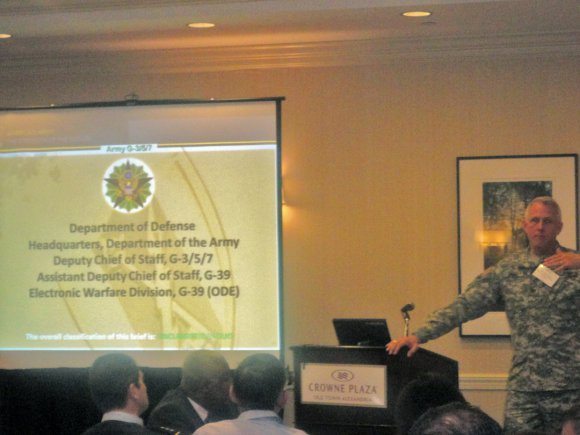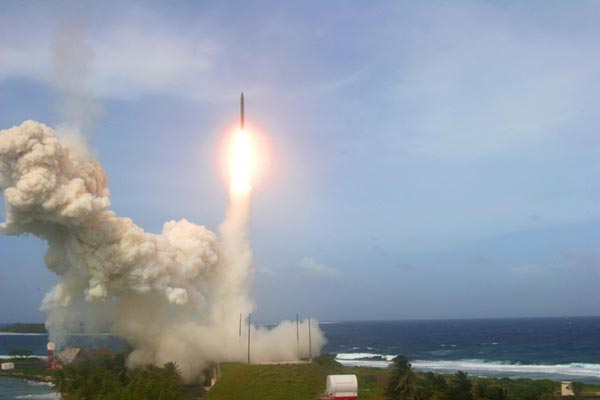Army electronic warfare is an evolving capability for the Army. Col. Jim Ekvall, the Headquarters, Department of the Army G-39 Electronic Warfare Division chief, had the opportunity to speak at the Institute for Defense and Government Advancement Electronic Warfare Summit, March 19, which just so happened to be the tenth anniversary of the beginning of the War in Iraq.
After deploying twice to Iraq himself, Ekvall can tell you first-hand how electronic warfare saves lives and is a much needed capability for the Army.
Thousands of miles from the streets of Baghdad or Fallujah, industry, military and scholars gathered at the Crowne Plaza in historic Old Town Alexandria, near the Pentagon, for the Institute for Defense and Government Advancement Electronic Warfare, or IDGA EW, Summit. Ekvall’s presentation focused on the evolution of Electronic Warfare, known as EW, within the Army, specifically during the past several years of warfare as well as where the Army plans to take electronic warfare in the future.
Ekvall began his presentation with an overview of the key players within Army EW.
Army EW has a broad base of players; Ekvall is the division chief of G-39 Army EW Division in the Pentagon, which provides Headquarters, Department of the Army, or HQDA, staff the oversight for the entire Army EW enterprise. Fort Leavenworth’s Mission Command Center of Excellence provides the oversight to the EW proponent office whereas the Program Executive Office in Aberdeen, Md., provides the oversight for the program manager of electronic warfare.
EW has its own MOS — the 29 series. Soldiers who choose this career path are trained at the Fires Center of Excellence at Fort Sill, Okla.
“Fort Sill has created a range which has the ability to train Soldiers how to operate within the electromagnetic spectrum and in a realistic battle scenario,” said Ekvall.
Communications systems for electronic warfare are supported at both the Intelligence Center of Excellence at Fort Huachuca, Ariz., as well as the Signal Center of Excellence in Fort Gordon, Ga.
Cyber electromagnetic activities were a large piece of Ekvall’s presentation. Ekvall highlighted that Army doctrine for, cyber electromagnetic activities, or CEMA, is comprised of three areas — electromagnetic spectrum operations, cyber operations and electronic warfare.
“These three areas are inextricably linked to one another. We are still evolving how cyber operations will work within the Army,” said Ekvall. “All of these areas must be synchronized for the commander to maneuver.”
On the battlefield, Ekvall emphasized that there was urgency for a material solution that would allow Soldiers to maneuver safely within the electromagnetic spectrum. Currently, the Army has several systems such as the Counter Radio-Controlled Improvised Explosive Device Electronic Warfare, or CREW, systems, and the communications electronic attack surveillance and reconnaissance, or CEASAR, among others. Ekvall explained that while all of these systems are important to protect the war fighter, more advanced systems are being planned.
“It is important for our senior leaders to know that EW is more than just a CREW system,” said Ekvall.
Aside from the CREW systems that are currently in use on the ground, the CEASAR program is an airborne electronic attack capability.
Future material solutions for the Army include the Integrated Electronic Warfare System, or IEWS. IEWS is a system of systems which will include the Electronic Warfare Planning and Management Tool, also known as EWPMT, Multi Function Electronic Warfare, or MFEW, and Defensive Electronic Attack, or DEA.
“In the long run we need an electronic warfare of tomorrow, and that is IEWS,” said Ekvall.
Ekvall emphasized that it was important for senior leaders within the Army and the Department of Defense continue to learn more about the need for EW not only during the current war, but to continue growing Army electronic warfare when the war concludes.
“I was happy to speak at the IDGA EW Summit,” said Ekvall. “Organizations such as IDGA are an excellent way which allows us to get our message out to the defense community. Educating senior leaders in industry, academia, and the in the military about what electronic warfare does for the Army will help grow the field and EW will continue down its evolutionary path.”











